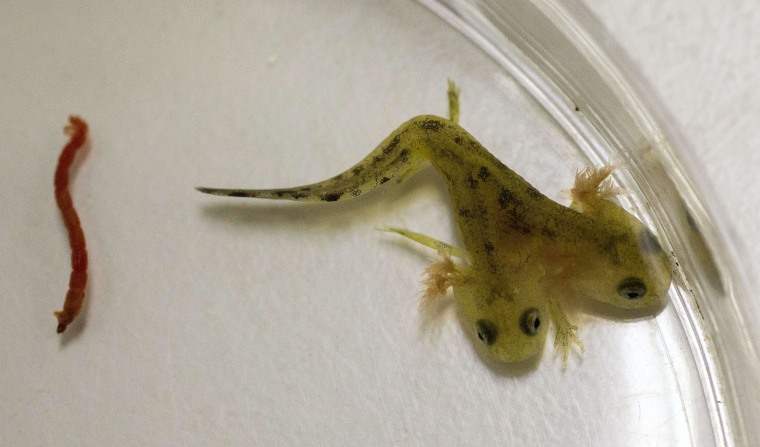Just call them "Arne" and "Sebastian." Those are the monikers given to the two separate heads of one baby salamander that was born last week in a lab in Israel.
Two heads are likely not better than one for the Near Eastern fire salamander (Salamandra infraimmaculata), which was born alive in a laboratory at the University of Haifa in Israel. Researchers aren't sure why the salamander tadpole has two noggins, but say random mutations or environmental pollution could be culprits.
"I could speculate, but it would be pure speculation," Leon Blaustein, an ecologist whose lab discovered the salamander, told LiveScience. [The 12 Weirdest Animal Discoveries]
Blaustein's team had collected pregnant female fire salamanders from the wild to give birth in the lab. (This species of salamanders gives birth to live young in a larval or tadpole stage.) A female that was gathered from a site called Kaukab Springs in the Galilee Mountains gave birth to the two-headed tadpole.
Both heads move, Blaustein said, but so far, scientists have seen only one preying upon a salamander baby's favorite meal, insect larvae. Blaustein gave the heads their names to honor two German scientists, Arne Nolte and Sebastian Steinfartz, with whom he collaborates on studying fire salamander ecology.
The Near Eastern fire salamander is listed as "near threatened" by the International Union for Conservation of Nature. in Israel, it is locally endangered, Blaustein said. Humans are the main reason the species is struggling. According the IUCN, human development is shrinking salamander habitat in Israel, Lebanon and possibly Syria. Water pollution is another threat, as is human water use for irrigation. Dams can disrupt salamander habitat by flooding the temporary, shallow pools and small streams where the amphibians thrive.
In Israel, Blaustein said, automobiles are killing salamanders on roadways and are a major problem.
— Stephanie Pappas, LiveScience
This is a condensed version of a report from LiveScience. Read the full report. Follow Stephanie Pappas on Twitter. Follow LiveScience on Twitter, Facebook and Google+.
